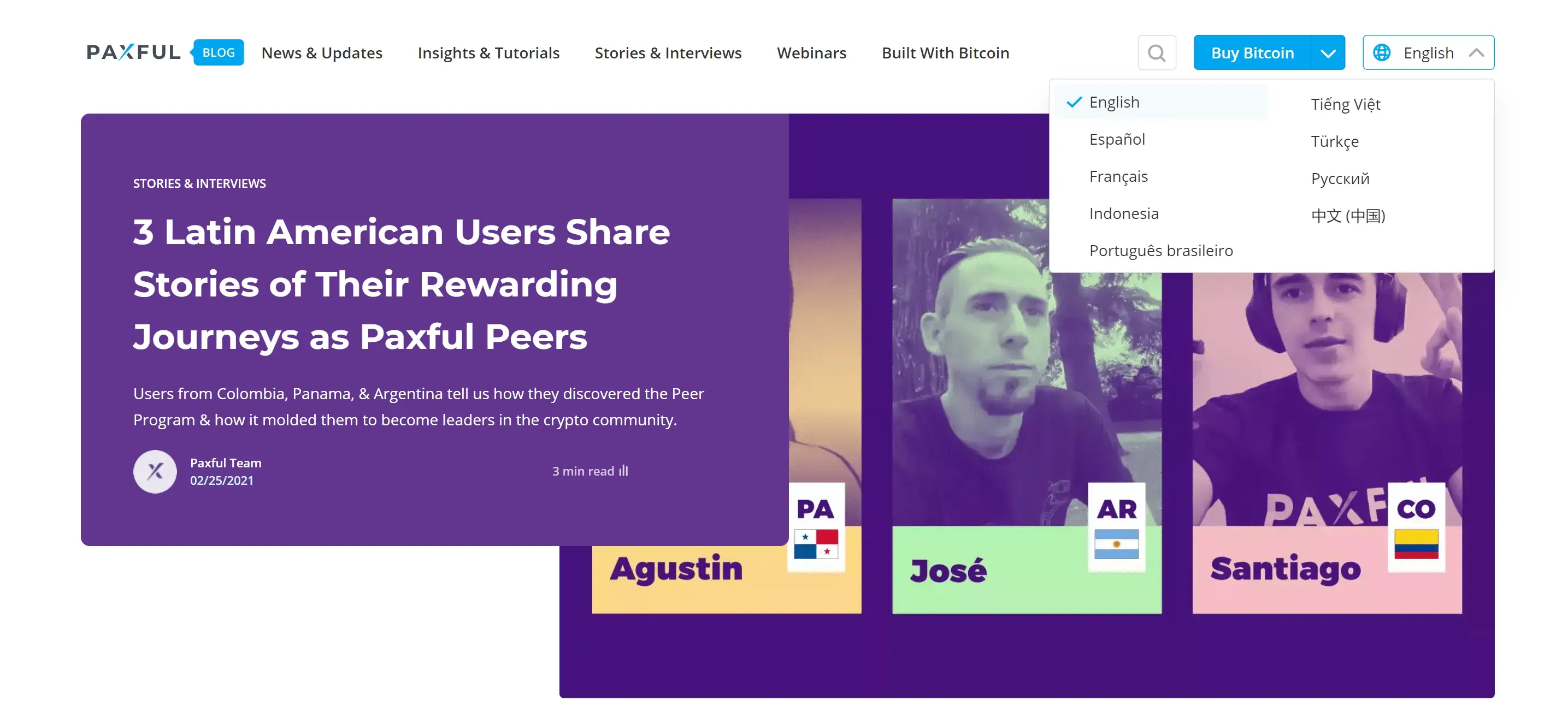Anna Iokhimovich is Head of Localization at Paxful, a global peer-to-peer platform for digital currencies. To her, localization is all about people.
In this Crowdin blog, Anna talks about her own journey, Paxful’s localization strategies and technology, her amazing localization team, building user experience into localization quality metrics, and what all new entrants to the industry should know.
A Crypto Platform That’s All About People
Paxful is a global peer-to-peer platform for buying and selling digital currencies such as Bitcoin and Tether, with further currencies being introduced later in 2021.
What makes Paxful stand out from the competition is their easy-to-use platform, and their support of a wide range of payment methods, over 350 of them. You can pay via bank transfer, with a gift card, or even with gold, which gives users complete freedom to trade any way they want.
To Head of Localization Anna Iokhimovich, Paxful is all about people, “We have a large community of devoted users. My role at Paxful is to make our services available to more people, in more countries, across the world.”
Paxful currently supports 20 languages but is gearing up for expansion and aims to double the count by the end of 2021. The top five languages for localization are Chinese, Spanish, Vietnamese, French, and Russian.
“Every new language you start is like buying a lottery ticket,” says Anna. “You might have done some analysis on the market, of course, but there is always an element of risk when launching a new language. But, over time, you get a lot of satisfaction from seeing trade and the number of users growing.”
Anna joined Paxful two years ago. She was given the freedom to build the localization team and workflows independently, to help the company grow and to achieve the best results possible.
The Paxful localization team now consists of three project managers and over 20 external, dedicated translators. Like any community, the crypto community has its own history, heroes, and lingo. Paxful’s localization team are part of the community and understand it, so they are literally speaking the same lingo as the users.
“We have a great team spirit,” explains Anna. “Our Slack channel is not just about work; we discuss everything from crypto investment strategies to our favorite TV shows. I trust my team with all my heart because they are traders themselves, so they know what they are doing.”
The Key to Growing as a Localization Manager
Anna has a degree in International Relations and started her career in localization ten years ago with no industry experience.
“I started as a localization project manager at a software development company, and it just felt right for me from the start,” Anna explains. “I had to learn from scratch how software development cycles work, but bit by bit, I started compiling the puzzle and seeing where localization sits within the ecosystem and where the dependencies between localization and marketing, customer support, finance, and product management lie.”
In her previous localization roles, Anna has had the privilege of working with two amazing managers who have been her mentors and guides.
“My first manager was an amazing teacher and role model, demanding but very human and polite, and open to sharing her knowledge. I’m very grateful for the opportunity she gave me, and we’re still in touch.”
In her second localization role, Anna had the fortune of working with another inspiring manager who taught her the ins and outs of the technical side of localization. These two experiences have strongly shaped Anna’s career.
“In my first job, I learned about project management and the linguistic side of localization. My second job was about tools, automation, and user scenarios, and how to automate anything. I guess you could say I have had the good luck of having both a professional godmother and godfather.”
Anna’s advice to new entrants to the industry is simple, “When you’re young and don’t have much experience or knowledge, it’s natural to feel like you’re not good enough. In the past, I’ve told myself that there’s nothing holding you back, just go and try, never be afraid of trying. You must do what frightens you most.”
As a localization professional, Anna passes it on, “Someone gave me a good start, and I do my best to help young people starting out in the industry. I have to pay my karma debt!”
Localization Process That Is One Part Tech, Nine Parts User Experience
For any company setting up their localization workflows, everything needs to be figured out from scratch: how localization works, which languages to pick, which tools to choose, how to set up your processes, what the impact of localization is on business, and so on. An experienced localization manager is crucial in this.
To Anna, localization is 90% people-focused, and technology is the facilitator, “Localization supports the way a company interacts with its users. First of all, it brings users to you. Then, it helps provide the service and satisfy the users’ needs, and keeps them happy. And finally, localization plays a key role in supporting the users.”
Marketing brings users to Paxful’s platform, and Anna’s team translates all marketing content including campaigns, emails, blog posts, social media posts, and localized SEO-optimized pages. Some processes remain manual while others run on automated workflows, like Paxful’s blog, which flows from their multilingual CMS to Crowdin and back again, with significant time-savings being achieved by automating this frequent workflow.

Paxful’s core service consists of two main products: the web functionality and the mobile app. Both products run on continuous localization cycles with full automation, with releases sometimes happening several times a day.

Anna sees her team as a constantly working localization machine, “Our localization factory is working 24/7. Our linguists are located all over the world, so there’s never a moment when someone is not translating something, and our engineers have established a smooth assembly line for us.”
The current process is fast, but Anna sees potential in making it even faster by pushing localization further up development so it can start earlier.
Customer support at Paxful has two streams: active and passive user assistance. Active assistance is live, human interaction, and Paxful provides live customer support in their most popular languages. The localization team translates templates with answers to typical questions, which saves the customer support agents a great deal of time when dealing with a specific user issue.
Passive user assistance takes place through Paxful’s knowledge base and Zendesk-to-Crowdin automation of translation, albeit with Paxful’s existing legacy workflow for now.
Apart from these core functions, Paxful localization team gets involved in a number of side projects and experiments, which Paxful initiates and encourages, along with other initiatives which the localization team is constantly trialing: workflows, languages, and models of vendor management.
User Feedback as Key Localization Metric
At Paxful, the team has established user feedback as a key metric for localization success.
A few times a year, Paxful runs a user survey on their website in every supported language, asking users how natural they feel Paxful sounds in their language, which gives the service a credible net promoter score. The second question is about what the user would like to improve in the existing content and whether they have spotted any issues. These give the localization team a very clear indication of how the localized languages are really doing.

They also regularly commission external LQA on localized content with a number of external vendors and build a picture of localization quality in a given language based on the collective LQA feedback.
The last piece of the puzzle are the business metrics, how much revenue each language generates. If a language is not doing well, it triggers Anna’s investigations and a drive to improve.
“At the end of the day, if the users like the service and the platform, they will use it,” says Anna. “If the users find and use the platform, and revenues grow, you are doing well. Our metrics tell us whether our languages are doing well or not, but we also get a lot of positive feedback from our users who say that it really sounds like we have created the platform in their language.”
A Love Letter to Crowdin Support
Paxful has been using Crowdin for several years, and it has a great track record in the development team and the wider Tallinn IT community.
“I really like Crowdin, and it’s also very good value for money,” says Anna. “I’ve recently noticed that there are some great changes. I especially like the function which allows you to select multiple screenshots, click a single auto-tag button and upload them in one go. It’s a small thing, but it saves me so much time, so whoever put that in, I’m sending them my warmest regards.”
Another tangible benefit of Crowdin for Paxful’s localization needs is its support of many file formats out of the box.
But it is Crowdin’s customer support that gets the most thanks from Anna. “We simply love Crowdin support. They have saved our bacon many times over these two years, especially Andriy. I’m not sure whether he ever sleeps or takes a vacation, but whatever you need, he figures it out. He either gives you a workaround or finds a checkbox setting which you never even knew existed. I made my translators very happy cleaning our legacy TMs with a workflow and a script that Andriy gave me. Andriy, you give us peace of mind!”
To Anna Iokhimovich, it’s hugely satisfying to see that the decisions she took early on are now paying off. Localization at Paxful is a key driver for business, and the returns on investment can be seen in new markets being conquered and in increasing user engagement.
Reach new markets with Crowdin
Khrystyna Humenna
Khrystyna Humenna is Head of Marketing, with over six years of experience in the localization industry. Her expertise is built on a deep understanding of various localization projects, informed by extensive customer interviews she has conducted.
